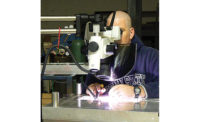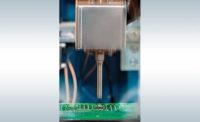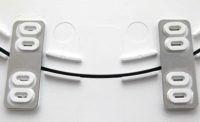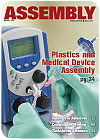
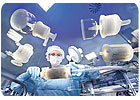
The medical device industry consumes billions of pounds of plastic every year.
Medical device manufacturers in the United States currently consume more than 2.7 billion pounds of plastic annually. And, there appears to be no end in sight; demand for plastics is growing more than 4 percent every year. By 2010, worldwide demand will exceed 8 billion pounds.
Plastic is used to assemble many different types of medical devices, including catheters, cuvettes, diagnostic test kits, filters, inhalers, IV bags, orthopedic implants, syringes and tubing. It’s popular because a wide variety of parts with complex geometries and intricate designs can be produced in high volumes. Plastics are inert, lighter and more suited to invasive, nonskeletal applications, such as valves and pumps.
Traditionally, connectors, meters, springs, valves and other critical medical device components are metal. But, many healthcare products rely heavily on injection-molded plastic parts today, because they offer cost benefits, especially for large runs.
Molded parts are more cost-effective than machined parts when there is a need for great repeatability of a given geometry in complex shapes. In addition, plastics can be blended to create hybrid polymers that suit particular needs.
Manufacturers are scrambling to find new ways to join all those plastic parts together. While adhesive bonding and ultrasonic welding remain popular, laser welding is making inroads. At the same time, medical device manufacturers are attempting to automate production, consolidate parts and reduce assembly steps. For instance, some manufacturers are pushing processing requirements further upstream by asking their mold vendors to supply devices with components, such as a cannula or a lancet, molded into the subassembly.
“No longer can engineers design products without clearly thinking about the assembly process while in the early stages of design,” says Len Czuba, president of Czuba Enterprises Inc. (Lombard, IL) and past-president of the Society of Plastics Engineers (Brookfield, CT). “Often, products are made the same way as before with small design changes only because there is a certain degree of comfort with the old-generation designs.”
Material Trends
When selecting plastic for medical devices, engineers are faced with more options-and more questions-than ever. “The plastic industry is investing in new technology to address the unique needs of medical manufacturers,” Czuba points out. “For instance, new catalysts and additives are allowing companies to blend different properties to create products without the high price tags typically associated with medical-grade materials.”Commodity plastics, such as polyethylene, polypropylene, polystyrene and polyvinyl chloride (PVC), are the most popular materials for medical devices, accounting for 80 percent of total consumption. The remaining 20 percent of the market is comprised of engineering plastics such as polycarbonate, polyamide, polyurethane, polyester and copolymers. Copolymers are materials, such as acrylonitrile butadiene styrene (ABS) and copolyester, that are made up of two or more monomers.
Approximately 30 percent of all medical devices use polyethylene, followed closely by PVC. However, the later material remains controversial. As a result, polypropyelne is becoming increasingly popular as an alternative.
“Polyvinyl chloride is the easiest [medical plastic] to process and the most versatile, but it continues to cause controversies [over plasticizer migration],” notes Bill Martineau, healthcare industry analyst at the Freedonia Group Inc. (Cleveland). “It is losing some growth momentum to thermoplastic elastomers, such as silicones, polyurethanes, polyesters, polycarbonates and easier-to-process grades of polypropylene. Producers are willing to sacrifice some processing ease for greater quality assurance, especially in products requiring biocompatibility.”
Polyvinyl chloride remains popular for catheters, dialysis bags, infusion bags, oxygen tents, and a wide variety of tubing and tube systems. It withstands high temperatures used in sterilization and it bonds easily with other types of plastics. Non-PVC tubing is more difficult to bond, because chemicals don’t react as quickly or as efficiently. Also, sealing, attaching and bonding non-latex products can be more challenging because of the materials that have been substituted for latex.
Nitin Phadnis, worldwide medical segment manager at Branson Ultrasonics Corp. (Danbury, CT), says many medical device manufacturers are shifting their attention to other materials. For example, he sees more demand for acetal, acrylic, polyetherimide, polyethylene and polypropylene.
“Manufacturers want to stay away from plasticized PVC because of the risk involved with DEHP [di-2-ethylhexyl-phthalate],” which is used to make medical devices softer and more flexible, explains Phadnis. Regulatory agencies in Europe and North America have expressed concern that DEHP could leach out from PVC and cause adverse health effects.
Phadnis says more medical device manufacturers are turning to engineering polymers, such as polycarbonates. The material is used for blood oxygenators, dialysers, inhalers and needle-less injection systems, in addition to miniature analysis and diagnostic equipment. It resists heat and radiation better than PVC and other common medical plastics. Polycarbonates also feature high transparency, which is important for medical devices where visual monitoring of fluids is necessary.
“Polycarbonates were one of the first of the engineering polymers,” adds Czuba. “But, they still have a high price tag. I am seeing a movement from traditional materials to next-generation materials, such as a switch from thermoset elastomers to thermoplastic vulcanizates (TPVs).
“These newer materials can be processed like thermoplastics and have the properties of thermosets,” explains Czuba. “They have reduced processing costs and save time in the long run. TPVs are used in valves and some limited uses with syringe pump piston tips.”
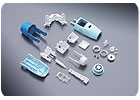
The components of this inhaler are made from copolymers.
New Applications
Orthopedic applications are expected to spur demand for new grades of medical plastics in the near future, especially bioresorbable materials, which can be easily molded. The world orthopedic biomaterials market, valued at $4 billion in 2006, is projected to accelerate in tandem with the world’s aging population, reaching $9 billion in 2012, according to a recent study conducted by Kalorama Information (New York).Changing demographics-particularly a world population that is expected to include 2 billion individuals aged 60 or older by 2050, improved longevity and higher quality-of-life expectations-are driving an increase in the number of musculoskeletal conditions being diagnosed and treated. In the United States alone, one out of every seven individuals report a musculoskeletal impairment.
Traditionally, titanium and polyethylene are used to make many orthopedic implants, such as replacement hips. But, researchers have been experimenting with new forms of polyurethanes and composites. “Eventually, corn-based polymers may replace durable polymers like polyethylene,” predicts Czuba.
No matter how medical plastics are used in the future, one thing is certain: Parts will continue to get smaller and smaller. “Minimilization and micromolding are growing trends,” says Czuba. “We’re seeing tinier products with more complicated mechanisms.” For instance, miniature pumps and valves are used for a wide variety of fluid control applications.
Bartels Mikrotechnik GmbH (Dortmund, Germany) recently unveiled a plastic pump that is only 5 millimeters tall and 25 millimeters in diameter. It weighs less than 1 gram and is used to pump gases and liquids. The entire device, except for the actuator, is made from injection-molded polyphenylene sulfone.
Several healthcare trends are driving down the size of medical devices. For example, information technology is enabling numerous telemedicine and home health care initiatives.
“Lightweight, yet durable materials enable devices to be designed in smaller formats for easier transport to its users or for conservation of precious space,” says Clare Frissora, market director of healthcare at GE Plastics Europe (Bergen Op Zoom, Holland). “Miniaturization and portability affect all components, from housings and structural elements to internal components, such as gears and latches.”
Unfortunately, small plastic parts can be extremely difficult to work with. “It’s very hard to control tolerances,” says Brad Rogers, business development manager for life sciences at EFD Inc. (East Providence, RI). As a result, medical device manufacturers are increasing their investment in automation.
“The need to reduce costs, improve efficiencies and eliminate headcount are driving the need to rely more heavily on automation,” notes Czuba. “Added to this is the remarkable progress made in improving automation systems, such as vision systems and motion control systems.
“It used to be that vision systems were only used in quality control or quality checking,” says Czuba. “But, now these same systems are being used to allow assembly, fill level control, and secondary processing and assembly.”
Of course, not all medical device assembly can be automated. Some parts cannot be oriented by high-speed equipment. automation doesn’t always make sense, especially for tiny devices that may have to be manually assembled under microscopes.
“A lot of products don’t allow automation, because of low volume and high complexity,” notes Rogers. “Most medical devices start in low volumes. As they move into development and acceptance, the possibility of automation increases. But, investing in an automated cell for a product that may not be around in a few years doesn’t always make sense.”
Sylvio Mainolfi, worldwide director of product marketing at Branson Ultrasonics, says the best types of medical devices to assemble automatically are products with few plastic parts that can be easily shuttled into position, such as filters, syringes, catheters, IV components, fluid transfer devices and analytical devices.
Assemblies with many internal working components, such as surgical staplers, are less likely to be candidates for automation. “Surgical devices and instruments are difficult to automate because of complexity and structure,” notes Mainolfi.
Joining Challenges
Medical device manufacturers can choose several different ways to join plastic injection-molded medical parts. The best process often depends on the nature of the polymer. Sometimes, several joining methods are combined. For instance, snap fits may be used to help align two parts, which are then firmly attached by adhesive bonding or ultrasonic welding.“The key challenges are getting the right type of joint design for any particular application and material combination, and developing the most optimal joining process that will produce consistent results,” says Phadnis. Ultrasonic, laser, vibration, hot plate and spin welding, in addition to adhesive bonding, all have advantages and disadvantages. “The challenge is to come up with a process that will produce the best results at minimal cycle times and meet quality requirements consistently,” Phadnis points out.
Engineers need to understand how changes in wall thickness can affect a part and its ability to be used in automated assembly processes. Too much variability in a component’s walls can lead to poor packing, the loss of key mechanical properties, warpage and other problems.
“For joining most any kind of plastic medical device, the biggest challenge is the shape of some of the devices,” adds Mike Luehr, marketing manager for medical devices at Dukane Corp. (St. Charles, IL). “There are some applications that would be great for ultrasonics, but due to the difficult shape or small size of the device, we end up recommending a laser welding system.”
Traditionally, plastic medical devices have been assembled with adhesives such as acrylics, cyanoacrylates and epoxies. Bonding is commonly used to join dissimilar materials. For instance, manufacturers use adhesive to attach stainless steel cannulas and lancets to plastic holders.
“There is a trend [toward using] two-part solutions for additional bonding strength and in the use of UV resins for flexible assembly purposes, particularly with clear plastics,” adds James Dornan, vice president of I&J Fisnar Inc. (Fair Lawn, NJ). No matter what type of adhesive is used, he says dispensers play a key role in the bonding process.
The majority of adhesive equipment can be quickly modified to vary the amount dispensed. In addition, dispensers can be physically moved to alternate assembly lines or processes.
Unlike welding operations, where the assembly equipment is tailored to specific part geometry, adhesives offer a fluid operation. They are often used for multiple assemblies or on next-generation devices where physical changes to the components have been introduced.
Adhesives and their associated equipment offer medical device manufacturers controlled dispense-not only in relative amount, but also in placement. When combined with robotic systems, adhesive dispensing can become an entirely hands-off process, thus minimizing worker involvement and exposure to liquid adhesives. In addition, dispensing automation can significantly reduce assembly costs by minimizing waste, reducing labor costs, and enabling manufacturers to use slightly larger adhesive packages.
“The use of adhesive dispensing and curing equipment facilitates a dynamic process-one that can be changed easily to accommodate slight changes in part configurations or production line setup and speed requirements,” says Christine Salerni Marotta, medical market development manager at Henkel Corp. (Rocky Hill, CT). “Dispensing systems, which are often utilized in automated device assembly, must be designed and selected with the particular adhesive in mind to ensure correct storage and handling of the fluid prior to and during dispense.”
“Pneumatic dispensers make medical device assembly easier by allowing a predetermined amount of fluid to be dispensed every time,” adds Rogers. “It all comes down to one word: consistency.
“Medical device manufacturers qualify not only their equipment, but also the components that are used with their equipment,” explains Rogers. “This qualification process involves, in most cases, determining the amount of adhesive needed to secure a particular device and then ensuring that amount is dispensed every time.”
Welding is another common way to assemble plastic medical devices. It’s a fast, clean, consistent joining process. Welding eliminates the use of adhesives and curing times, which helps improve throughput. Once process parameters, such as time, force, depth and amplitude, are dialed-in, welding is consistent cycle after cycle. That precision and reliability is important in an industry that’s constantly concerned about meeting stringent FDA requirements.
“With demand for medical devices growing, the need to automate assembly processes is more than evident,” says Phadnis. “Welding allows the assembly process to be faster, as compared to the use of solvents, glues or mechanical fasteners. And, since there are no consumables involved, the process is less expensive.”
Most medical device manufacturers use ultrasonic, laser or vibration welding. “There is a need for equipment that delivers accuracy, repeatability and good record keeping,” says Luehr. “With manufacturing going global, it is important to maintain the quality control necessary to produce good products.”
Ultrasonic plastic welding has been around since the early 1960s. Medical device manufacturers like the technology because it’s fast, repeatable and accurate. They use it to assemble a wide variety of products, such as blood analysis devices, hearing aids, endoscopic equipment, filters, heart valves and pumps, knee and hip replacement joints, microfluidic devices, monitors and surgical instruments.
But, there are several challenges to using ultrasonic welding for medical device assembly applications. “There are limitations in terms of size,” says Phadnis. “Complex geometries are difficult to weld, and there are some materials that do not work well with ultrasonics.” For instance, polyethylene and polypropylene are less suitable than ABS.
Particulate generation is another big concern, especially with small fluidic devices, such as blood testing equipment. Because of this issue, laser welding is starting to gain market share in the medical device industry. “Advantages of lasers include minimal thermal stress on the welded parts, no particulate matter and an optically perfect weld joint,” Luehr points out.
Lasers are especially effective for welding lap joints. Manufacturers use diode lasers to assemble microfluidic devices, balloon-tipped catheters, filters, tubing and other products. However, one big drawback of laser welding is that clear parts typically cannot be joined without first applying a carbon black absorber.
Some manufacturers are using a new process developed at The Welding Institute (Cambridge, England) that makes it possible to weld two transparent plastic parts. For instance, Natvar Corp. (Clayton, NC) is using the additive technology to assemble tubing used in intravenous therapy, hemodialysis, cardiovascular, catheterization and angioplasty applications.
Despite those advances, many medical device engineers still shy away from lasers because of their steep price. Laser welding is more expensive than adhesive bonding or ultrasonic welding.
“The price tag has come down quite a bit in recent years,” says Luehr, who has been in the industry for 20 years. “Although the initial investment may seem high, the equipment will pay for itself due to reduced scrap, improved cosmetics, and the elimination of damaged internal components and particulates.” A
Click "Web Extra" to learn more about plastic medical device trends.

